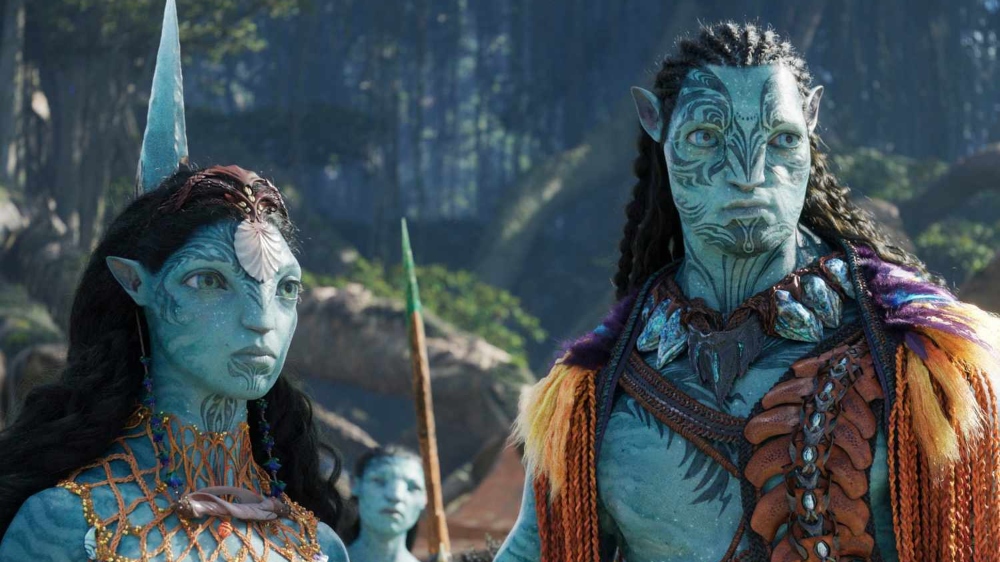Ever since the unparalleled success of Titanic made writer/director James Cameron the King of the World, the cinematic world has wondered whether he would ever go back to the water. In Avatar: The Way of Water, the much-anticipated sequel to the astonishingly successful 2009 film, Avatar, Cameron has done so. His return trip is mostly a welcome marriage of the two narrative themes and styles that propelled his last two movies to worldwide stardom. Indeed, The Way of Water is almost like an experimental fusion of the two stories behind the two previous films, with an additional layer about the fealty to family sitting somewhat awkwardly on top of them. Really, the reason to watch this film is the jaw-dropping visual effects and production values that it displays, a visual wet dream for any below-the-line enthusiast.
Avatar: The Way of Water is set 10 years after the events of the original film, which makes sense considering it took Cameron over 13 to make good on his promise to deliver sequels to the original story. We encounter Jake Sully (Sam Worthington), who is now living permanently as a Na’vi — the blue-skinned race of tall creatures that embody the mysterious, colorful world of Pandora—and is married to his love interest Neytiri (Zoe Saldaña), with whom they have formed a large, loving family. Neither Worthington nor Saldaña necessarily achieved the levels of stratospheric stardom one would have expected from the success of the first movie, perhaps hurt by the motion capture and somewhat wobbly script that defined it. One actress who did see her career catapulted to the stars by a Cameron vehicle, Kate Winslet, also makes an appearance, as Ronal, a member of the “Metkayina” tribe of sea-dwellers in Pandora. She plays a pivotal character in what proves to be a renewed war with would-be human colonizers. Who, in essence, continue to lust after the Na’vi’s technology and resources.
Also back in the cast are Sigourney Weaver and Stephen Lang. The former plays a completely different character (Kiri — Jake and Neytiri’s adopted teenage daughter), and the latter plays a sort of humanoid, revived zombie of his former self, the growling human Colonel Miles Quaritch. That these two actors can return is emblematic of the world The Way of Water inhabits: this is a world of science fiction, pure and simple, with all the pitfalls and wonders that this cinematic genre usually entails. Those looking for high-brow philosophizing on the meaning of life would best be served to look elsewhere.

Not much else may be said about this movie’s story without criminally spoiling it, but nothing else is surprising, either. In its 3-plus-hour runtime, Cameron and co-screenwriters Rick Jaffa and Amanda Silver (who worked on the Planet of the Apes prequels), hew closely to the Titanic/Avatar story structure: long, wonderful exposition, with a moment of climatic tension reaching its apex around the two-hour mark, followed by a very welcome, no-holds-barred assault on the senses denouement, punctuated by tragedy, heroism, and destruction. It sounds greater than it really is, because the familiar structure will seem a bit dull to even the most devoted Cameron fans. The focus this time around is another war between Na’vi and humans, mostly the old forces of the Colonel’s vindictive RDA forces, though now, apparently in an effort to stick to a story that was previously effective, a big ship is added in for good measure, and the sacrifices one makes for family are again front in center.
The crux of The Way of Water is its below-the-line values, particularly the visual effects, which once more rest heavily on motion capture. But, never a slouch, Cameron upped the stakes considerably by setting so much of his story underwater, creating a whole new challenge for the motion capture markers and cameras, which did not interact necessarily well at the beginning with the air and reflective surface above them. By the time we get to the film, though, Cameron and his Weta FX crew have perfected the technique while the devoted actors have learned to spend long periods of time underwater without breathing. The end result is a stunningly real depiction (because it mostly is) of characters interacting underwater, putting Aquaman to visible shame and raising expectations for upcoming underwater live-action films like The Little Mermaid. The “how on Earth did they do that” effect continues almost entirely unabated for the long runtime, as motion capture and VFX mix with Russell Carpenter‘s blue-tinted, gorgeous cinematography to create one of the most memorable visual experiences at the movies in some years.

Elsewhere, composer Simon Franglen is a worthy successor to longtime Cameron collaborator James Horner, having studied underneath in projects like Titanic. That said, Franglen’s style is much more effusive and light than Horner’s cymbals-heavy, clashing work, giving The Way of Water a more ethereal film than some of Cameron’s more tense-sounding films. Editing by a team that includes Cameron himself as well as Stephen Rivkin, David Brenner, and John Reoufa. Through a series of rapid and then slower editing techniques, the foursome creates additional speed and action in a story that is already packed with it. It may be nearly 200 minutes, but The Way of Water at times flows calmly but forcefully like a determined river, and the careful editing pace is mostly to thank. And the incredible career of costume designer Deborah L. Scott, whose award-winning work includes Titanic, Avatar, and Back to the Future, adds another impressive notch to its belt. The new Na’vi sub-race, in particular, provides her the greatest opportunity to add new structures and tones to the costumes, making this feel unusually fresh and innovative for a high-budget sequel.
By the time the credits roll for The Way of Water — and it becomes clearer even to those who do not read that trades that a sequel is in the cards no matter what — it is challenging not to conclude that James Cameron has somehow outdone himself again and that 13 years were well worth the wait. The story of this film is good enough and does not break any ground (nor does it aspire to, clearly). Instead, Cameron and his time have put their A+ effort behind creating something sensorially unique, a rich combination of blue-hued palettes with creatures that come from the grandest of imaginations, all surrounded by swelling music and magical colors. Really, how do they do it? How do they get the screen to jump out in that vivacious, pulsating way, and I do not mean just the trick of the 3D glasses?
We will run a series of interviews with the below-the-line talent for this spectacular film in short order, in search of some answers. The one that comes to mind immediately though is that these are passionate, talented filmmakers and that their love of this art form has all been put into the effort of advancing it.
Grade: A-
Avatar: The Way of Water is now playing in theaters across the globe courtesy of 20th Century Studios.





